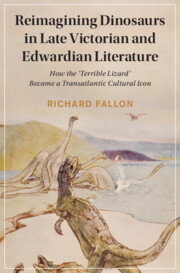 Reimagining Dinosaurs in Late Victorian and Edwardian Literature
Reimagining Dinosaurs in Late Victorian and Edwardian Literature Book contents
- Reimagining Dinosaurs in Late Victorian and Edwardian Literature
- Cambridge Studies in Nineteenth-Century Literature and Culture
- Reimagining Dinosaurs in Late Victorian and Edwardian Literature
- Copyright page
- Contents
- Figures
- Acknowledgements
- Note on Scientific Terminology
- Introduction Dinosaurs in Transition
- Chapter 1 Reclaiming Authority: Henry Neville Hutchinson, Popular Science, and the Construction of the Dinosaur
- Chapter 2 Reinventing Wonderland: Jabberwocks, Grotesque Monsters, and Dinosaurian Maladaptation
- Chapter 3 Rearticulating the Nation: Transatlantic Fiction and the Dinosaurs of Empire
- Chapter 4 Rediscovering Lost Worlds: Arthur Conan Doyle and the Modern Romance of Palaeontology
- Conclusion Dinosaurs Rewritten
- Notes
- Bibliography
- Index
- CAMBRIDGE STUDIES IN NINETEENTH-CENTURY LITERATURE AND CULTURE
Chapter 2 - Reinventing Wonderland: Jabberwocks, Grotesque Monsters, and Dinosaurian Maladaptation
Published online by Cambridge University Press: 28 October 2021
- Reimagining Dinosaurs in Late Victorian and Edwardian Literature
- Cambridge Studies in Nineteenth-Century Literature and Culture
- Reimagining Dinosaurs in Late Victorian and Edwardian Literature
- Copyright page
- Contents
- Figures
- Acknowledgements
- Note on Scientific Terminology
- Introduction Dinosaurs in Transition
- Chapter 1 Reclaiming Authority: Henry Neville Hutchinson, Popular Science, and the Construction of the Dinosaur
- Chapter 2 Reinventing Wonderland: Jabberwocks, Grotesque Monsters, and Dinosaurian Maladaptation
- Chapter 3 Rearticulating the Nation: Transatlantic Fiction and the Dinosaurs of Empire
- Chapter 4 Rediscovering Lost Worlds: Arthur Conan Doyle and the Modern Romance of Palaeontology
- Conclusion Dinosaurs Rewritten
- Notes
- Bibliography
- Index
- CAMBRIDGE STUDIES IN NINETEENTH-CENTURY LITERATURE AND CULTURE
Summary
Chapter 2 explores a range of fictional and non-fictional writing on dinosaurs. The first half shows how different writers, including Henry Neville Hutchinson, Grant Allen, and geoscientist Henry Woodward, invoked the comic monsters of Lewis Carroll to develop a new, ‘grotesque’ register for describing dinosaurs. This language naturalised an emergent understanding of dinosaurs, especially American dinosaurs like Triceratops, as having gone extinct owing to the evolution of uselessly monstrous characteristics. These ideas were appealingly absurd to general audiences, who could contrast the progressive traits and intelligence of mammals like themselves with the doomed grotesqueness of the dinosaurs. The chapter’s second half examines this new way of talking about dinosaurs, providing close readings of humourist Eugene Field’s poem ‘Extinct Monsters’ (1893), Edward Cuming’s Wonders in Monsterland (1901), and Emily Bray’s Old Time and the Boy (1921). In addition to depicting dinosaurs through Carrollian nonsense conventions, all three of these texts were direct responses to the works of Hutchinson, demonstrating his long-term importance for the popularisation of dinosaurs.
Keywords
- Type
- Chapter
- Information
- Reimagining Dinosaurs in Late Victorian and Edwardian LiteratureHow the ‘Terrible Lizard' Became a Transatlantic Cultural Icon, pp. 63 - 98Publisher: Cambridge University PressPrint publication year: 2021
